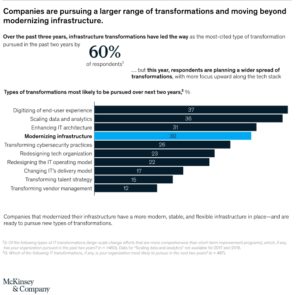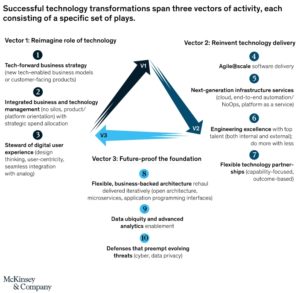COVID-19 has created a massive humanitarian challenge: millions ill and hundreds of thousands of lives lost; soaring unemployment rates in the world’s most robust economies; food banks stretched beyond capacity; governments straining to deliver critical services. The pandemic is also a challenge for businesses—and their CEOs—unlike any they have ever faced, forcing an abrupt dislocation of how employees work, how customers behave, how supply chains function, and even what ultimately constitutes business performance.
Confronting this unique moment, CEOs have shifted how they lead in expedient and ingenious ways. The changes may have been birthed of necessity, but they have great potential beyond this crisis. In this article, we explore four shifts in how CEOs are leading that are also better ways to lead a company: unlocking bolder (“10x”) aspirations, elevating their “to be” list to the same level as “to do” in their operating models, fully embracing stakeholder capitalism, and harnessing the full power of their CEO peer networks. If they become permanent, these shifts hold the potential to thoroughly recalibrate the organization and how it operates, the company’s performance potential, and its relationship to critical constituents.
Only CEOs can decide whether to continue leading in these new ways, and in so doing seize a once-in-a-generation opportunity to consciously evolve the very nature and impact of their role. Indeed, as we have written elsewhere, part of the role of the CEO is to serve as a chief calibrator—deciding the extent and degree of change needed. As part of this, CEOs must have a thesis of transformation that works in their company context. A good CEO is always scanning for signals and helping the organization deliver fine-tuned responses. A great CEO will see that this moment is a unique opportunity for self-calibration, with profound implications for the organization.
We have spoken with and counseled hundreds of CEOs since the pandemic first hit. It is clear to us that they sense an opportunity to lead in a new, more positive and impactful way. If a critical mass of CEOs embraces and extends what they have learned during the pandemic, this CEO moment could become a CEO movement—one that is profoundly positive for the achievement of corporate, human, and societal potential. As Rajnish Kumar, chairman of the State Bank of India, reflects, “This will be a true inflection point. I think that this pandemic, in terms of implications, will be as big an event as World War II. And whatever we learn through this process, it must not go to waste.”
(…)
Invest further in building relationships with other CEOs
CEOs are communicating more, and expanding their networks, in part because only another CEO confronting the pandemic can fully identify with today’s leadership challenges. As Laxman Narasimhan, CEO of Reckitt Benckiser, puts it: “I find talking to other CEOs about how they are handling the crisis extremely helpful—this shared experience connects us and gives me added perspectives.” Says AmerisourceBergen CEO Steve Collis, “From an external perspective, I’ve been a beneficiary of amazing calls with other CEOs who have been willing to share their knowledge. This has been such a growing experience.”
Hospital CEOs realized we were chasing each other around the supply chains [hunting for PPE]. So we began to coordinate. It became almost a daily call.
— Kate Walsh, CEO, Boston Medical Center
It’s no surprise that CEOs are seeing the benefits of connecting in new ways during this crisis. The urgency of the moment has given focus and urgency to the nature of the dialogue. Kate Walsh, CEO of Boston Medical Center, started talking to her peers early in the pandemic, when Boston was becoming one of the country’s COVID-19 hot spots. “Hospital CEOs realized we were chasing each other around the supply chains,” says Walsh. “We began to coordinate, so at least we could let people know that we’d give everybody a mask when they come to work on Monday morning. It became almost a daily call [with other hospitals] as we tried to figure out how to respond to the volume of cases.” Leaders are less focused on showing up to large group meetings and putting on a corporate face that suggests “We’ve got it under control.” Instead, they are intent on accelerating problem solving together by building on one another’s ideas, iterating novel solutions to use in the workplace, trading notes, and moving forward having learned what works best. They are also encouraging one another to conduct bold experiments, taking advantage of the current environment to do A/B testing on a massive scale and trying new ways of operating virtually and digitally.
In order for CEOs to leverage such interactions in the future and accelerate impact on shared challenges, they will have to continue to approach such opportunities—both formal and informal—with humility, a learning mindset, and an open-minded commitment to ongoing development. The benefits of doing so are more significant than one might imagine: role modeling this has the potential to create more open learning organizations for companies, and to identify the cross-industry analogies that often provide the touchstone for innovation. Without the pressure of a crisis, however, leadership resolve will be required to maintain such an approach—research makes it clear that none of this is easy for people in powerful roles.
In light of the newfound connectivity among CEOs within and across industries happening in this moment, CEOs will benefit from reflecting on the following questions:
- What peer networks should I continue or create beyond the crisis (in particular, those in analogous but not identical situations)?
- What makes for a valuable peer interaction, and how can I ensure that these conditions are in place when I interact with other CEOs?
- Beyond role modeling, how can I encourage my senior team and other leaders to enrich their own networks and the velocity of learnings with their peers across industries?
Leverage networks to tackle a broad set of issues
CEO networks also have a unique potential to enable some of the other things we have talked about thus far in this article. CEOs in noncompetitive industries are well positioned to both challenge and support their peers in aiming higher; in sharing learnings, best practices, and encouragement regarding elevating “to be” to the same level as “to do”; and in working through how to fully embrace stakeholder capitalism.
COVID-19 has brought with it a pressurized operating environment the likes of which few of today’s CEOs have ever experienced—it has “unfrozen” many aspects of the CEO role.
The pharmaceutical industry’s “10x” rush to counter COVID-19 bears witness to this. As Christophe Weber, CEO of Takeda Pharmaceuticals, explains, “We started the development of a plasma-derived medicine for COVID-19 by ourselves. But our head of Plasma-Derived Therapies realized that if we formed an alliance with other plasma companies, we could go much faster and would have the potential to produce a product on a bigger scale. So now we have a pro bono, not-for-profit alliance. And we have a very good alliance with other major plasma companies, smaller ones, and also nonplasma companies, like Microsoft. When everybody saw that it was a true alliance to do good for society, we were able to get the convergence of many companies.”
This interest in shared success can create wins for multiple stakeholders. “Part [of the adjustment to COVID-19] is focusing even more on partnering with and supporting the community,” says CCHMC’s Fisher. “For example, CEOs of major employers, including P&G, Kroger, Fifth Third Bank, Cincinnati Children’s, and others, initiated a task force to focus on a robust and inclusive restart of our economy and region. Being part of those things is more important than ever to me, our institution, and our community.”
Alain Bejjani of MAF frames the potential for CEOs to work together in ways that change the world for the better. Says Bejjani, “Employers enjoy the highest level of trust compared to governments and even NGOs [nongovernmental organizations]. This capital of trust is very important and something CEOs should leverage going forward. We should be at the bridgehead for change. Governments cannot win, cannot deal with the complex issues of our time, without business. Business, in turn, cannot win without government and civil society.” As COVID-19 has made clear, changing the world for the better is good not only for society but also for business.
As CEOs look forward to decide what issues to tackle with their peers, they can build on their pandemic experience by considering the following questions:
- On what issues has peer connectivity most benefited my business, now and in the future?
- On what societal issues (such as inequity and racism, climate change, porous social safety nets, weakened healthcare systems) should peer connectivity be directed, and how can I maintain the same level of intensity that I did during the pandemic?
- What issues will I take personal leadership on and convene others around?
COVID-19 has brought with it a pressurized operating environment the likes of which few of today’s CEOs have ever experienced. It has necessitated a reappraisal of how much is possible and in what time frames. It has forced personal disclosure at levels previously considered uncomfortable and, in doing so, has increased awareness of the importance of how leaders show up personally. It has shined a light on the interconnectivity of stakeholder concerns. It has prompted a level of substance-based, peer-to-peer CEO interaction that has elevated all involved. Ultimately, it has “unfrozen” many aspects of the CEO role, making possible a re-fusing of new and existing elements that could define the CEO role of the future.
When the pressure decreases, will CEOs go back to operating as they did before? Or will the role at the top be thoughtfully reconsidered and reconceived by those who occupy it? Clearly, not every CEO will choose to make permanent the four shifts we’ve discussed. The more that CEOs do, however, the more the moment has the potential to become a movement—one that could create higher-achieving, more purposeful, more humane, and better-connected leaders. Judging by the evolution underway, many companies and societies stand to benefit.
About the authors: Carolyn Dewar is a senior partner in McKinsey’s San Francisco office, Scott Keller is a senior partner in the Southern California office, Kevin Sneader is McKinsey’s global managing partner and is based in the Hong Kong office, and Kurt Strovink is a senior partner in the New York office.
The authors wish to thank Monica Murarka for her contributions to this article.
More: McKinsey.com






